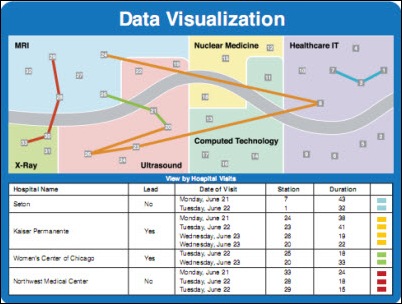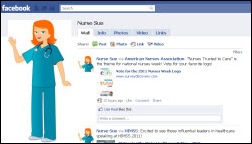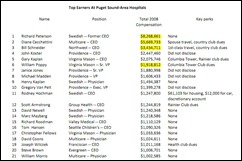Re: Cerner Millennium at VA This is shaping up to be a real popcorn-worthy situation! Possible outcomes: 1). Trump throws…
News 12/22/10
From Vendor Prez: “Re: RFID tagging of HIMSS conference attendees. I think this is appalling. As an exhibitor, the last thing I want is for the attendees to feel more ‘targeted’ that they already do. Frankly, if exhibitors can’t get attendees in their booth on their own merit, they don’t deserve to capture key information from drive-bys. This is pitiful and my company will not be participating. We will however, proudly display the HIStalk Sponsor poster that you always drop by!” Above is the end result of tracking us attendees like stray cattle via the RFID chip tucked away in our badges. Vendors pay $3,000 for the basic package up to more than $20,000 for a turnkey tracking service. You can opt out on your conference registration like I did. And thanks to Vendor Prez for displaying our amateurishly made “We Power HIStalk” signs in their booth. I know it’s hokey, but we are really proud that many HIStalk sponsors participate because they want to support what we do. As you might imagine, I really appreciate that.
Speaking of which, you would think the stray cattle tracking company could at least spell the name of its excessively vendor-friendly partner correctly.
From Chatty Cathy: “Re: instant messaging. Do nurses typically use it in hospitals to communicate with each other and with doctors? Just curious.” In mine, the PCs are theoretically locked down and IM clients aren’t allowed, although I’m sure someone has figured out a way to bypass that (like using an online chat client like Meebo or the ones built into Yahoo or Google). I like the question, though, and would appreciate comments. It’s a pager-driven world in many hospitals, made kind of IM-ey with Amcom’s Web-based paging app that lets people chat primitively back and forth. Staff could also use SMS messages or specific VoIP apps. They could even use FaceTime video calling if they have iPhones or iPads.
From IT Begins: “Re: Ingenix. Appears to be the first steps of unveiling strategy around the recent acquisitions.” Inga covers it below, but Bethesda Healthcare System (FL) chooses Ingenix to manage the revenue cycle of both the hospital and its outpatient services. Ingenix will provide its Electronic Financial Record, coding solutions, patient financial counseling, an ED information system (since it bought Picis and can offer ED PulseCheck), and full-time employees in scheduling, registration, HIM, PFS, and decision support. It sounds like a great business move, although odd that a hospital would hire a company owned by an insurer to manage its revenue cycle, most of which involves dealing with insurance companies. Who better, right?
From Epic User: “Re: FDA oversight of EHRs. Epic’s ‘fear of stifling innovation’ doesn’t resonate with this long-time user of their applications. They routinely fail to prioritize making simple changes to their system (icons, language on screens, similar functions in different applications) that are consistent and would reduce user confusion / error. They also fail to prioritize making enhancements to their systems requested by customers year after year (apart from the annual voting, which is application-based and not focused on consistency across applications), and instead focus on new features that help sell the systems (e.g. focus on ‘what sells’ vs. ‘what’s useful’. If FDA oversight stifles their innovation and helps make their systems more consistent from application to application in terms of functionality, user experience, etc. then that’s a good thing.” Here’s who I blame for that: customers and prospects, since most vendors work pretty much the same as you describe, i.e. creating what the market demands. If customers don’t like their apps or feel they endanger patients, then it’s their fault for writing that check anyway. I’m growing weary of hearing how big, bad vendors prey on helpless health systems and their excessively paid C-level leadership who can’t be bothered to understand exactly what they are getting in return for their many, many millions of dollars or creating a vision of how it could be better. I’d like to see better applications, but those voting with their dollars are saying otherwise – guess whose vote counts? If there’s a demand for iffy software applications, unhealthy Big Macs, or illegal drugs, economics assures that someone will meet that demand.
This is sobering, but not surprising: Fitch Ratings downgrades the bonds of Lima Linda University Medical Center (CA) BBB with a negative outlook due to poor liquidity and inconsistent financial results (54 days days cash on hand). Once concern is the $1.4 billion it will need in capital over the next 10 years, mostly for seismic compliance requirements (which management has already said they can’t possibly meet) and implementation of electronic medical records.
The chief nursing officer of Capsule, Susan Niemeier, receives a slew of social media awards for her work under the pseudonym Nurse Sue.
KLAS releases a report covering single sign-on, concluding that high customer expectations aren’t always met, but that they are generally glad they implemented it. Imprivata edged out Microsoft (Sentillion) for the top ranking.
This sounds like something I’d come up with: UMass Memorial Health care allegedly hires hot models for $75 per hour to approach mall shoppers and football game attendees and ask them to give cheek swab DNA samples for its bone marrow registry. Those agreeing were told that their insurance would pay the $100 charge, only to find that their EOBs showed charges of $8,400, not to mention that many of them may not have been made aware that they were obligating themselves to donate marrow if they matched. A hospital worker supposedly told the models, for which the hospital paid up to $4 million, to wear short black skirts, heels, a white lab coat, and colorful wigs.
Good news: today is the shortest day of the year, meaning it can only get better when it comes to driving home from work in the dark.
The guy who robbed and shot Wheaton Franciscan Healthcare IT VP Tim Belec in WFH’s parking lot three year ago is finally sentenced to 12 years in prison after pleading guilty to a single charge of attempted intentional homicide. I never heard how Tim did after taking two bullets in the chest, but I Googled his name and articles I ran across indicate that he’s back on the job at WFH.
A Dean Health System (WI) doctor breaks hospital rules by storing patient information on her laptop, which was then stolen. The hospital sends the usual “so sorry, how about some free credit protection?” letters to 3,000 surgery patients. And in Virginia, Centra notifies 14,000 patients that their billing information was exposed when an employee atttending a Georgia conference has her laptop stolen from her rental car.
Cerner opens a Collaboration Center in its London offices. I’m not clear on what its point is, but the Cerner UK GM says it will help clients “identify their respective organisational imperatives, such as financial savings or patient safety initiatives, and align them with the capabilities of Cerner Millennium.” I guess it’s like a Vision Center for existing customers.
David Brailer’s Health Evolution Partners launches Halcyon Home Health, which he says will “redefine how home care is delivered” through clinical excellence and IT. Its Web site (above) isn’t quite ready.
The government of Hong Kong starts the next phase of its EHR project, soliciting proposals for pilot projects and interface work that involve patient-facing health applications and standard terminology. Proposals are due by January 31.
Healthland’s inpatient EHR earns CCHIT certification as a Complete EHR.
I happened to drive by one of those consumer lab store fronts the other day and noticed a somewhat fun sign in their window pitching their lab tests: “Sex, Drugs, and Cholesterol.”
iSoft finds a new source of revenue: offering another company’s technology that will extract information from its EMR and de-identify it for researchers (hopefully not selling it outright). The Cliniworks platform sounds kind of cool, actually.
The GAO says HHS missed the 2007 date set by Congress to develop a plan for an electronic system to support sharing of information in public health emergencies. I guess they aren’t Meaningful Users.
Clinical trials software vendor DrugLogic files suit against Oracle, claiming patent violations related to two life sciences software companies that Oracle acquired, Relsys and Phase Forward. In the mean time, Oracle turned in killer Q2 numbers, with revenues up 47% to $8.6 billion and profit up 28% to $1.9 billion.
The local Massachusetts paper runs an interview with eClinicalWorks CEO Girish Kumar Navani, focusing on the company’s local economic impact and impending move to bigger quarters. Tidbits: eCW will be hiring 100-200 people in 2011, it has more than 1,300 employees, its new building will cost $18 million, 2010 revenues are expected to be $130-$150 million, and its five-year goal is to have 100,000 providers and 100 million patients.
We’re having the usual semi-lame holiday events at work this week (you can’t say Christmas, of course, since somebody’s lawyer would show up before you finished the sentence). There are always a few really disturbing souls wearing Santa hats in an unwelcome public display of carefully orchestrated holiday exuberance (especially since they are usually the really obnoxious people or oddballs who haven’t said a peep since last Christmas). There’s the white elephant gift exchange, which everybody hates because it comes with pages of rules and the person who organizes it always seems to parlay their knowledge into ending up with the only good gift. There’s the door decorating contest, where hastily covering a door with old gift wrap and cut-out occupant pictures is considered extraordinary effort worthy of a noble prize, like a free frozen yogurt in the cafeteria. Leftover celebration food is dumped unceremoniously and anonymously on break room tables, fallen upon instantly and ravenously by beaming IT geeks who should be applying some of their vaunted analytical skills into questioning whether it’s a good idea to eat something that’s been standing at room temperature in a different conference room or office until everyone got tired of looking at it and decided to deposit it in the collective food trough rather than throw it out (hey look, everybody, there’s deviled eggs in the break room!) Guys wear hideous light-up Santa ties and ladies show up in Christmas sweaters smelling of mothballs from their once-yearly exposure to air (the sweaters, not the ladies). But the worst thing is that it will be over in a week, leaving a long stretch of no holidays as the serious work restarts. I’m going to study this holiday phenomenon once I finish my current observational research that questions why a large percentage of men puzzlingly spit in the urinal before or after using it for its intended purpose.
A Puget Sound-based public radio station compiles a list of the 86 “top-earners” from area hospitals, including 15 executives who earned over $1 million in 2008. On top: former Swedish CEO Richard Peterson, whose total package exceeded $8 million.
The 600 physician member Morris-Somerset IPA (NJ) contracts with eCast Corporation for its ACO-Care HIE product.
Essent Healthcare (TN) selects ProVation Order Sets from Wolters Kluwer Health as its electronic order set solution. Essent operates five hospitals across four states.
Billings Clinic (MT) signs a multi-year agreement with Craneware for five charge process applications and implementation services.
Child Health Corporation of American will offer LodgeNet Healthcare’s eSuite interactive television solutions to its owned hospitals.
More than a quarter of doctors in the Czech Republic have declared their intention to resign and emigrate to a better-paying country if their government can’t address pay concerns, long hours, and poor working conditions. The starting base salary for a Czech physician is about $11,000 year. In nearby Germany, pay is about $96,000 a year. Government officials claim the current financial crisis prevents them from increasing doctor pay.
Vista Health System IPA and Central Jersey Physician Network IPA form a new accountable care organization, Optimus Healthcare Partners LLC. The organization will initially include 650 physician members.
HIT consulting firm PHNS realigns its management team following its acquisition by the ConJoin Group. PHNS founder Richard S. Garnick will remain as CEO.
The Texas Organization of Rural & Community Hospitals Foundation is offering QuadraMed’s ICD-10 Countdown Program and Readiness Assessment Services to its 150 member hospitals. Almost 70 hospitals have already contracted for the program.
mdi Consultants will be the anchor tenant for the Nashville Medical Trade Center, according to the center’s management company. Market Center Management Company also announced the creation of a Global Business Development Center to be located within the center. The 1.5 million square foot development is scheduled to open in 2013 and expected to attract 160,000 visitors a year.
Sponsor Updates
- Wishard Health Services (IN) expands its use of Surgical Information Systems (SIS) products to include SIS Anesthesia, SIS Analytics, and SIS Com.
- Ochsner Health System (LA) goes live on Orion Health HIE.
- CDW and Greenway Medical Technologies announce a partnership to offer a practice EMR package that includes PrimeSUITE 2011, technology, and services.
- BayCare Health System (FL) partners with MEDSEEK to develop and deploy an integrated eHealth solution for consumers, patients, clinicians, and employees.
- Bethesda Healthcare System (FL) picks Ingenix to manage RCM functions for its hospitals and outpatient facilities. Ingenix will deploy its Electronic Financial Record technology as well as provide full-time onsite staff to manage RCM functions.
- Momentum Billing LLC (CA) chooses Advanced MD’s medical management software for its medical practice operations and RCM business.
- McKesson says that Community Hospitals and Wellness Centers (OH) is the 100th hospital to go live on its Paragon HIS.
- Cumberland Consulting Group has been honored as a Patriotic Employer for supporting employees who serve in the National Guard and Reserve. The company was nominated by Major John Gobel, one of its consultants who served 20 years in the Guard, stayed on in the Reserves, and served in Iraq.
I stepped away from my HIStalk duties yesterday and met with The Jolly Guy. I shared with him my special request for fabulous boots. Santa said, “maybe.” True story: he asked me to leave out a glass of vino on Christmas Eve, in lieu of milk and cookies. My kind of Santa.
Send holiday greetings to Inga.













Re: Instant Messaging
The worst thing you can do is lock everything down and disallow everything but email because what will happen is that staff will always find a way to achieve their goals outside of the system. Then what you will end up with is ePHI being transmitted via Text Message, Via Twitter, Via Facebook. Engage your staff, form a user advocacy group (different from a Steering committee) and find out what is needed on the front lines. Then give them an avenue to achieve it with some well documented processes and procedures.
I’m disappointed that your photo with the Jolly Old Elf cut off any glimpse of your fabulous shoes!
[From Inga – just as well that my feet were cut off. I did happen to be wearing some fabulous shoes – so fabulous that they would have had to be “de-identified” to protect my identity!]
On Oracle, they just won their own big patent lawsuit and in the news of late there seems to be quite a few patent lawsuits emerging and for some reason or another they seem to take place after a big conglomerate buys the smaller company? On the selling of data, that is a big problem today and I read somewhere that the AMA made around $44 million with selling information, but the number seemed a little high, but who knows anymore with everyone marketing any stick of data they can get their hands on with the big move going for predictive behavior analytics anymore. I’m getting tired of having my body stuffed into a data base and having to deal with all those queries created:)
I found a good Larry Ellison video this week, It’s in the Box, The Cloud That Is, These Are Boxes…he’s making up for a few years ago when he was caught off guard on the clouds:)
http://ducknetweb.blogspot.com/2010/12/oracle-ceo-ellison-its-in-box-cloud.html
You almost do have to have a place somewhere in your heart for Larry as his record breaking Oracle IPO was outdone the very next day by Bill Gates for even more money with Microsoft, so he is the come back kid.
Mr. HisTALK – A bit of the Scrooge in you? Sheesh, what’s with the complaining about the Santa hats? Did your door only get an honorable mention and was the prize some lame thumb drive?
[From Mr. HIStalk] People wearing Santa hats along with normal attire creep me out (like clown suits, mimes, and people who refer to business entities comprised of millionaire professional athletes as “we”). But then again, I am a curmudgeon (not just a Scrooge since I’m that way year round).
Mr. HIStalk:
RE: Current observational research that questions why a large percentage of men puzzlingly spit in the urinal before or after using it for its intended purpose.
I was at the Patriots-Packers this past weekend. As I approached the urinal to perform my pre-game routine, I did noticed a high percentage of men spitting in the urinal before and after using it. I too was curious and look forward to the results of your research. Ha-Ha. Merry Christmas Mr. HIStalk and a wonderful New Year 2011.
re: IM. An upcoming version of Agfa’s IMPAX PACS has an IM chat feature built-in. It’s contained to the PACS clients, so there’s nothing to lock down. It will be interesting to see how it’s used in the real world.
“Epic User” wisely discussed the problem of non-responsive vendors with wrong priorities. Your response, alas, was naive economics 101 silliness that ignored the realities of large capital purchases. You “blamed” the purchases for continuing to write the checks to the vendors. But that blame misses the fact that if you’ve invested $150 million in an enterprise EHR/CPOE system, and spent another $500 million in implementation, training, cross-covering, customization, etc — you ain’t gonna easily pull your HIT system out and buy another one. The vendors have you over a barrel. Now you also said that the buyers should be more careful before they buy the systems. That advice is of course correct. But I’d point out that the original comment was made by a Mr. or Ms. “Epic User,” who, we may assume, is not using the worst of the systems…and even he/she is encountering those problems. (A ubiquitous complaint, btw.)
Moreover, as the HITECH legislation obliges us to buy these systems, we’re sort of stuck with picking among the limited number of vendors, where even the “best” are non-responsive with misplaced priorities.
responding to Chatty Cathy…
Do clinicians want to instant message? The answer is YES, YES, YES! Voice communication requires availability of both parties – you have to be free and I have to be free for us to talk. How often are caregivers available to talk? Almost never!
How often do you hear nurses and doctors complaining about “tele-phone tag?”
When you look at what is being communicated, it is small snippets of information that does not require immediate notification – things like:
Patient needs ice in room 305
IV Pump beeping in room 205
I am going on break for 15 minutes
These snippets should be text messages – not voice calls.
With smartphone’s entering the point of care, the capability to instant message is being extended to the nurses’ handset and we will see an immediate upswing in text messaging as a preferred means of communication (and when I say text messaging, I am referring to secure, presence based instant messaging – not SMS).
Text will never fully replace voice… there are times where you need to have a conversation with someone and text will not suffice, but to optimize communication at the point of care Voice, Alarms, ant Text are all required.
-Trey
Why does that data visualization look strikingly familiar to Minard’s depiction of napoleon’s disastrous march?
Charles Babbage and Mr. H, I agree with you both to some degree re: the Epic User comments. I would say, though, that a major part of the problem is that customers really don’t know what they want. Keep in mind that customers are not end users, but hospital administrators. End users often have very little say in the system chosen and aside from a few well-placed individuals, very little say on how it’s run. Government regulation has given some structure and a more clear goal to the marketplace, but beyond that structure, everyone wants something different. Healthcare is a fickle marketplace, where everyone wants to “see the evidence” before jumping in full force to adopt anything new – or wait to see how many class-action lawsuits pop up against those who took the risk and adopted innovation early. Innovation is not really embraced in HIT, so vendors who want to innovate end up with no revenue stream. Vendors like Epic that give the marketplace what it thinks it wants are hailed as industry leaders, even though they’re not really doing anything unique or innovative. I fear that Charles Babbage is correct in the sense that the Epic systems are so expensive that health systems will be stuck with those systems for years to come, with no innovation coming behind that. Once we’ve all reached stage III, we’ll just be mired in Epic’s mediocrity.
Instant Message: YES! Our nurses have been piloting Voalte for quite some time. My colleagues from prior hospitals are astonished to hear that we have supplied our nurses with Iphones for quiet communication. We were really surprised at the amount of texting and the physician satisfaction of being able to locate staff. You have a quick way to prioritize your requests and get help from colleagues from unit clerks to pharmacists. Want a quiet hospital? Go with texting!
I spit in a urinal before I pee and I have NO IDEA why I do it. I don’t do it in the toilet in my house.
I am desperate for Mr H to do a major study on the matter.
Alternatively Inga could ply me with drink at the HIMSS (or is it HIMMS now?) HISTalk party and talk direct to my subconscious.
Either way the answer would be forthcoming–even if I’d enjoy the latter methodology more
RE: Epic User
Well stated. It leads me to believe that all Epic, Cercer, Siemens, and Sunrise users on the front lines of clicking should be heard. As of now, they are muzzled by hospital wide code of conduct rules whereby if they go public with criticisms, reports of adverse events, and more, the admin goes after them with their form of “peer review”. Last week, I had the opportunity to cover for another doc at another hospital (will not name the device) using a CPOE different than what I normally use. The best description is that it was a box of idiosynchracies that kept me from providing patietn centered care. I asked the ICU doc what he thought of the EHR and CPOE. He looked around to see if anyone was listening. He said, “it is a disease”.
Charles Babbage already covered what I wanted to say: once the contract is signed, all of those little details go out the window. A C-level executive can’t effectively push for 50 or 100 little consistency fixes, because she is just one out of many, many customers with requests. You can’t expect the invisible hand of the market to sweat the small consistency issues, but they are so important. That’s why we need oversight that will sweat the small stuff.
It’s a problem of incentives. Vendors are incentivized to wow prospective clients (which is done with cool new features, not small safety changes). Current customers are so invested in the system that vendors don’t have to work nearly as hard to keep them happy. Keeping them just happy enough not to leave is the mission, and that isn’t enough of an incentive.
What’s being lost in this back-and-forth? Patients. I’m an EMR believer, and I don’t think all of the vendors are evil. But I think that a mandate to adhere to clear usability rules is the best thing that could possibly happen to the industry because it would realign their currently perverse incentives.
I blame the spitting on the allergies. That’s my excuse and I’m sticking to it.
I didn’t see the option to opt out of RFID. Although, to be honest I think it will be fun to see how it works and if it does anything for vendors. A lot of people find it disturbing and so that’s what has me so interested.
Chatty Cathy –
if you want to text – and I believe you should – all of these should end up in the chart – is here a way to document all of these texts?